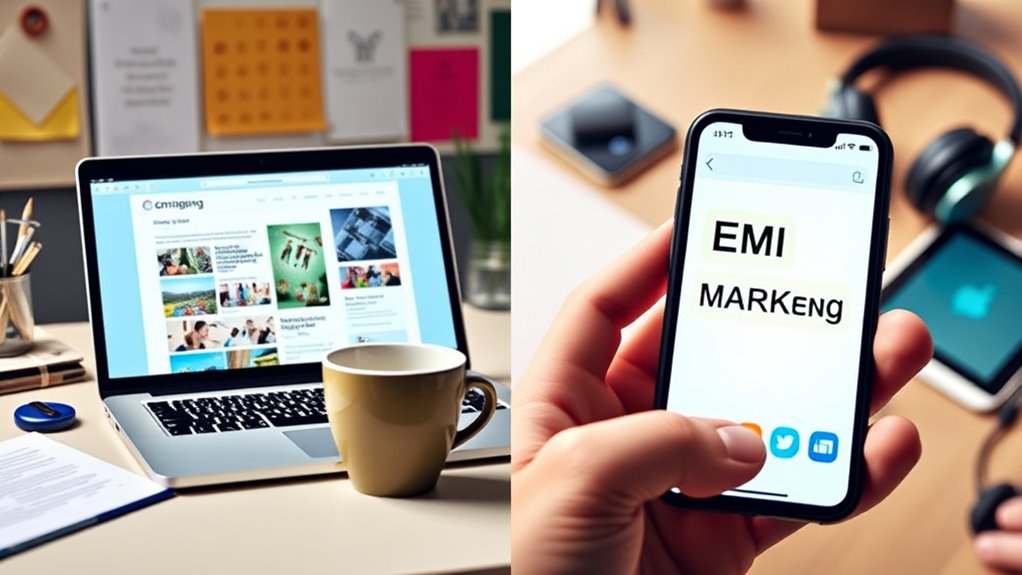Email and SMS marketing each have unique strengths to help you connect with your audience. Email is versatile, allowing detailed content, images, and automation to nurture relationships over time. SMS delivers quick, high-response messages perfect for urgent updates or time-sensitive offers, with higher open rates. Combining both channels lets you maximize engagement while reaching people effectively. Want to see how to balance these tools for your marketing goals? Keep exploring to discover more.
Key Takeaways
- Email allows for detailed, personalized content ideal for relationship building, while SMS offers immediate, high-open-rate messages for urgent communication.
- SMS delivers messages instantly with higher response rates but tends to be more costly per message compared to email’s lower-cost, scalable campaigns.
- Email supports automation, scheduling, and analytics for long-term nurturing, whereas SMS is best for time-sensitive alerts and quick engagement.
- Combining both channels leverages email’s depth and SMS’s immediacy, optimizing overall marketing effectiveness and customer reach.
- Audience preferences and campaign goals should guide the strategic use of email for relationship building and SMS for instant interaction.

When it comes to digital marketing, email and SMS stand out as two of the most effective channels to reach your audience. Both methods have unique strengths that can help you boost customer engagement and improve your overall marketing ROI. Understanding their differences is essential to developing a strategy that maximizes impact while staying cost-efficient. Email marketing offers a versatile platform for nurturing leads, sharing detailed content, and building long-term relationships. It allows you to craft well-designed messages with images, links, and personalized touches, making it ideal for storytelling and informational campaigns. Since emails can be scheduled and automated, you can maintain consistent communication without constantly micromanaging each message, which contributes to cost efficiency. Additionally, email campaigns often have lower costs per contact, making them scalable for businesses of all sizes. You can reach hundreds or thousands of customers with minimal expense, and the ability to segment your audience ensures your messages are relevant, increasing customer engagement. Moreover, email marketing supports analytics that help measure campaign success and optimize strategies over time.
On the other hand, SMS marketing delivers messages directly to your audience’s mobile devices, often with higher open and response rates. When you send an SMS, it’s typically received within seconds, creating an immediate connection. This immediacy can markedly boost customer engagement, especially for time-sensitive offers, alerts, or reminders. Because SMS messages are concise and straightforward, they demand less effort from recipients, which means they’re more likely to read and respond. From a cost efficiency perspective, SMS marketing can be more costly per message than email, but its high engagement rates often justify the investment. It’s particularly effective for quick updates or calls-to-action that require prompt attention. Combining email and SMS allows you to leverage the strengths of both channels: email for detailed, nurturing communication, and SMS for instant, impactful messages.
Understanding the importance of target audience preferences and behaviors can help tailor your communication channels effectively. Your choice depends on your goals and audience preferences. If you want to build a relationship over time and share in-depth content, email is your best bet. For immediate responses or urgent notifications, SMS shines. Both channels, when used strategically, can enhance customer engagement and provide a cost-efficient way to reach your target market. The key is to integrate them seamlessly into your marketing mix, ensuring your messages are timely, relevant, and aligned with your overall objectives. By doing so, you’ll create a more dynamic communication strategy that resonates with your audience and maximizes your marketing investments.
Frequently Asked Questions
Which Marketing Channel Offers Better ROI Overall?
Think of marketing channels as a treasure map—SMS is your swift, direct arrow, hitting customers instantly, while email is a detailed guide, nurturing relationships over time. SMS often offers a higher ROI because it excels at precise customer targeting and personalized messages that grab attention fast. If you want quick wins, SMS is your best bet; for long-term engagement, email can be equally valuable.
How Do Privacy Laws Impact Email and SMS Campaigns?
Privacy laws profoundly impact your email and SMS campaigns by enforcing data privacy and regulatory compliance. You must obtain explicit consent from recipients before sending marketing messages, ensuring you’re compliant with laws like GDPR and CAN-SPAM. These regulations require you to protect customer data, provide opt-out options, and avoid spamming. Ignoring these rules risks legal penalties, damaging your reputation, and losing customer trust, so always prioritize data privacy and regulatory compliance in your marketing efforts.
Can Combining Email and SMS Improve Customer Engagement?
Think of combining email and SMS as creating a dynamic symphony that captivates your customers. By integrating interactive content and personalization strategies, you can reach them on multiple levels, boosting engagement. When you blend these channels, your messages become more relevant and timely, sparking curiosity and action. This synergy turns passive recipients into active participants, making your marketing efforts more memorable and effective.
What Are the Costs Associated With Each Marketing Method?
You’ll find that email marketing costs vary based on your pricing strategies and audience targeting, often involving subscription fees or platforms fees. SMS marketing usually incurs per-message charges, which can add up with high volume. Both methods require investment in quality content and targeting tools. While email may be cheaper for broad audiences, SMS can offer more immediate engagement, so consider your goals and budget when choosing your approach.
How Do Mobile Device Preferences Influence Channel Effectiveness?
Picture your customers browsing on their smartphones, where device adoption is high and notification preferences vary. You see that SMS often grabs quick attention with its instant alerts, aligning with those who favor immediate updates. Meanwhile, email appeals to users who prefer detailed messages and longer engagement. By understanding these mobile device preferences, you can choose the right channel—SMS for fast, urgent messages and email for in-depth content—maximizing your marketing impact.
Conclusion
You might think email and SMS marketing are just different tools, but they actually work best together. Combining the two creates a powerful synergy that boosts engagement and conversions. Don’t believe the myth that one always outperforms the other—your audience prefers personalized, timely messages across channels. When you leverage both wisely, you’ll see better results and stronger customer relationships. So, embrace the dual approach and watch your marketing efforts reach new heights.









